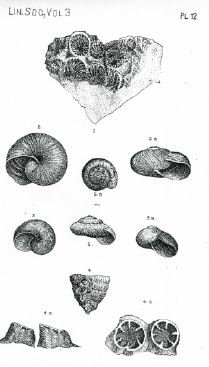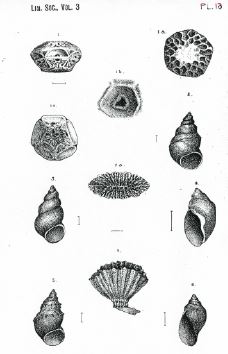page 131
ON SOME NEW EXTRA-TROPICAL CORALS.
By the REV. J. E. TENISON-WOODS, F.L.S., F.G.S., &c.
Plates 12 and 13.
Some short time since, Capt. Hutton, Professor of Natural science in the University of New Zealand, and Curator of the
page 132
Dunedin Museum, sent me some corals which he had collected at Auckland, Wellington, &c. I propose to describe two of them here, together with a small one from the north-east coast of Australia. The first was found on some old metal near the slip at Wellington, therefore may have been introduced. But it should be mentioned that the metal is lead and not copper, and probably not from a ship's bottom. It has been pronounced by some naturalists of experience in corals, to be a worn specimen of Cylicia Smithii, but this it cannot be for the following reasons: The calices have no epitheca, but very distinct costa. There is no columella, but the septa meet in the centre and throw up long slender processes which are like a columella when seen from above. Many of the calices are cemented by a very compact granular coenenchyma, which rises almost to the edge; and finally the calices in this specimen, though broken, are not worn as the most delicate of the slender processes from the septa are unbroken. The false coenenchyma is peculiar, but still I think not of generic importance, for like the epitheca, it seems to be secreted or not according to the exigences of the animal. This is one of the facts which tend to show that the whole group of the Astrangiaceoe needs revision. There is also a marked peculiarity in this genus, which is that the calices seem to have grown by throwing out another calicular margin above and outside the old one, through which the septa are continuous, so that the old margin forms a crescentic line of endotheca within. This new wall rises on the higher side, and gradually slopes and unites with the lower side, so as not to be seen there. I am not aware that the species has been hitherto described, and I therefore propose to dedicate it to my learned friend Capt. Hutton, whom am happy to acknowledge, as one of the most zealous and industrious naturalists of the Southern Hemisphere.
CYLICIA HUTTONI. Plate 12, fig. 1.
Corallum very short, only slightly inclined, and regularly and broadly oval; no epitheca, but a false exotheca, compact, and granular, often uniting the calices, and completely filling up the space between them; costa distinct, broad, flat, granular, corres-
page 133
ponding to the septa; calices deep; septa thin, close, not exsert, very faintly and finely granular; systems six, cycles four, but the fourth wanting in two systems; primaries smooth at their upper edge, deeply and very delicately lobed in the lower part, where the lobes form a false columella;* on the higher side of many of the calices there is a second margin as mentioned above. Dimensions, alt. 3 1/2 to 4, maj. diam. 5, min. diam. 4.
In the curious specimen which is figured, it will be observed that one of the calices seems partially formed within a larger one, and that in another there is one septa-costal processes almost extending, as in some of the Astraea, across to the contiguous calices. The figure of plate 12, fig. 1, is slightly enlarged.
I have already observed in my monograph of the Australian extra tropical corals that there is much confusion about the habitats of the species of Cylicia given in Edw. and H. Prof. Duncan refers C. Smithii to S. Africa.
The species to which I next call attention belongs to the fifth group of the Astrean family, the Astrangiaceoe or corals which multiply by buds on a basilar expansion. It is a very small species and has only one complete cycle, with rarely in some systems the rudiments of a second. There is only the slightest trace of any serrations at the edge of the septa and the visceral cavity is completly fiat and smooth at the bottom and not even a remote sign of a columella. The size of the calices and the fewness of the septa might induce one to suppose that they were young specimens. But the buds of any species known to me are not at all like this, and as the calices become narrower from the base to the summit, though it might increase the number of. septa would not enlarge the calice. There are two very small species of Cylicia referred to by Messrs. Ed. and H., but they are doubtful as to their being really members of the genus. The absence of any signs of a columella and the entire septa are generic distinctions, yet I think it better for the present to place this interesting species amongst the Cylicicioe.
* This is seen very clearly when a section is made across the calic.
page 134
CYLICIA VACUA, n.s. Plate 12, figs. 4, 4a, 4b.
Corallum very small, circular, much inclined, with a broad base which sends out thick rounded buttress-like expansions; costa broad, obtusely angular, corresponding with the septa; epitheca shining, covering the corallum with numerous small chevron-like close rounded folds, giving rise to a "herring-bone" pattern; calice circular; wall thin, somewhat higher than the septa which are six in number, not exsert, projecting very little into the calice, only slightly more advanced at the base than at the calicular edge, and all studded at the base with long processes projecting at right angles from the face; no columella. Dimensions, alt. 1 1/2, lat. 2 mil.
On Flabelbum rubrum, Wellington, New Zealand. Plate 12, fig. 4, coral on Flabellum,, nat. size, 4a, side view, much enlarged, 4b, coral seen from above.
The following coral is remarkable as being a third species of Placotrochus differing considerably from the two previously known. It is smaller, more solid, and with a distinct pedicel. There are three known Australian Miocene species, namely, P. deltoideus, P. elongatus, and P. elegans. From all of these also it differs in its pedicellate form. It is not so small as P. elegans, but is more solid.
A synopsis of the fossil species would stand thus-
1. Broad and pointed, P. deltoideus;
2. Narrow and pointed, P. elongates;
3. Base nearly as long and broad as calice, P. elegans.
The synopsis of the living species is as follows:-
1. Short with a basilar scar, P. loevis;
2. Long with a compressed spine at the base, P. candeanus;
3. Flabellate and pedicellate, the present species.
PLACOTROCHUS PEDICELLATUS, n.s. Plate 13, figs. 7, 7a.
Corallum small, flabellate, rather solid, rising from a thick wide pedicel, from which it spreads abruptly (instead of sloping gradually) at rather more than a right angle; costa little raised, obtusely angular, covered with very distinct close herring-bone markings; calice narrowly elliptical, the two ends of the major axis sharply angular, and about half the whole height below the
page 135
minor axis, from which the marginal outline is regularly curved; fossa shallow, not so deep as the line along the major axis; septa thick, granular, not exsert in four cycles of six complete systems; fourth and fifth orders very small, the rest equal; columella thick, rising in two lobes and attached to some of the septa by processes which proceed from them; pedicel broadly elliptical. Dimensions, alt. 5, maj. axis 5, minor 2 1/2, alt. of pedicel 2, diam. in direction of maj. axis 2, minor 1.
Princess Charlotte Bay (?) 10 fathoms. Hon. W. Macleay. Plate 13, fig. 7, corallum much enlarged ; fig. 7a, calice.

